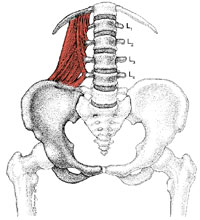The Mighty Quadratus: Part 2 The Quadratus and Gait
Acting unilaterally without the ipsilateral foot fixed on the ground, it can raise the ilia on the side of contraction (as in a pull up or side bend on a Roman chair). The quadratus lumborum was more active than other muscles during isometric side support postures where the body is held horizontally almost parallel to the floor as the subjects supported themselves on one elbow on the floor together with both feet.
It is active during single limb support during stance phase of gait on the contralateral side (along with the external oblique) to elevate the ilium. This is coupled with the ipsilateral anterior fibers of the gluteus medius and minimus pulling the iliac crest toward the stable femur.
Sahrmann states “the QL is optimally situated to provide control of lateral flexion to the opposite side via its eccentric contraction to provide control of the return from lateral flexion via its concentric contraction. The muscle is also positioned to play a role in the rotation that occurs between the pelvis and spine during walking”. This makes you really think about the interplay of this muscle, and another stance phase stabilizer, the psoas major, which attaches opposite the QL on the anterior aspect of the vertebral body, IN FRONT of the transverse process.
Acting bilaterally, it extends the lumbar spine, deepening the lordosis and acting to limit anterior shear of the vertebral bodies.
It is able to stabilize the 12th rib during forced expiration, thus acting as an accessory muscle of respiration. This fixation is important when we need to superimpose pelvic movements upon it. Furthermore, it increased activation in response to increasing compression in static upright standing postures.
Bottom Line?:
Think of the QL, especially during gait abnormalities or recalcitrant low back pain. The more it is stressed, the more it is activated. If someone had mild weakness of the stance leg gluteus medius, it may be called into play to pick up some of the slack. Expect to see increased activity paraspinally, with particular attention paid to the 12 rib attachments.
In our flexor dominant society, the QL may play a role in generating unilateral shear forces on the lumbar spine (along with the ipsilateral psoas), especially in individuals with poor ankle rocker or decreased hip extension.
The QL: it’s not only for breakfast anymore…..
We still are…The Gait guys

















